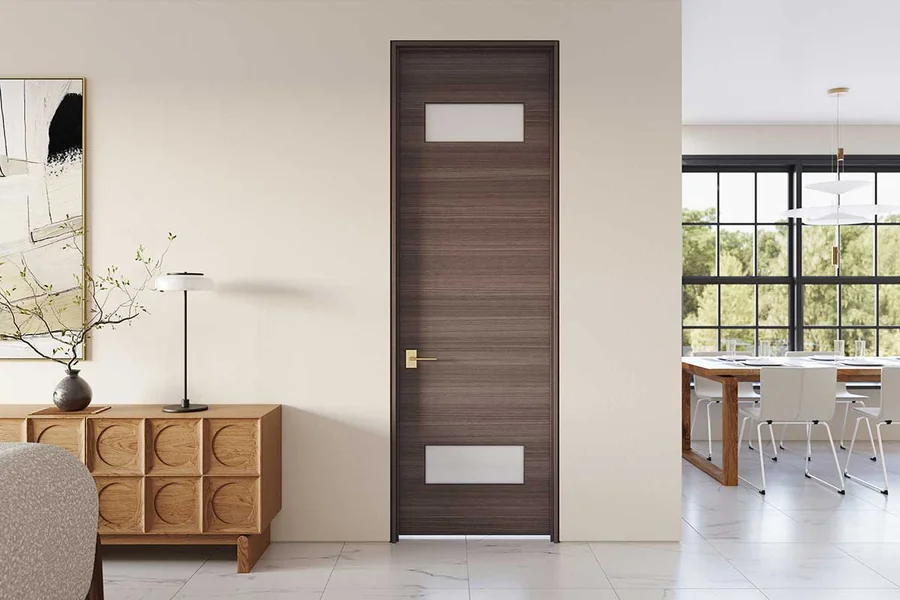Door sizes are among the key factors to consider when constructing or renovating a house. It is very easy to make the height of a door the focus when determining how a door meets the needs of functionality and safety, but then the width also plays an equally relevant role. The standard door width will help homeowners, builders, and architects maintain consistency and accessibility while also complying with building codes. Whether it’s an interior room, the front entryway, or a commercial facility, the correct door width will determine the design, the placement of office furniture, and ease of maneuvering.
In this article, we’ll explore what defines standard door width, how it varies based on usage and location, and how it works to standard door height to create comfortable and efficient spaces.
What is the Standard Door Width?
The general dimension of the door width in residential buildings is a range of 28 to 36 inches, with 32 inches being the most popular size, according to the contents. External doors, particularly those at the front entrance, are usually wider in measure to afford greater comfort of access, and they have a size of approximately 36 inches. These dimensions align with the recommendations of building codes and accessibility standards, such as the Americans with Disabilities Act (ADA) in the U.S.
Matching the standard door width with the standard door height, which is usually 80 inches (or 6 feet 8 inches), ensures that doors fit properly within common frame sizes. This uniformity eases the construction and the later modification or upgrading of the doors.
Variations in Door Width by Type
A wide variety of door widths is required in various rooms or different spaces, depending on the purpose of the room or space. For example, bathroom doors are typically narrower, measuring 28 inches, compared to the 32 inches used in bedrooms or hallways. Depending on the design taste, closets can be even narrower at the doors. In commercial buildings, the typical width of a door can exceed 30 inches to accommodate increased traffic, move equipment, or facilitate emergency egress.
Despite these variations, the standard door height often remains consistent across all types, reinforcing the importance of balanced dimensions. A well-proportioned door not only appears more aesthetically pleasing, but it also meets ergonomic requirements.
Accessibility and Code Requirements
ADA suggests that the clear width associated with the door at a 90-degree angle should be at least 32 inches. This provides access to wheelchairs and mobility machines through it. Depending on the jurisdiction, there may be a wider door code requirement in commercial or public places.
Pairing the standard door width with the required standard door height allows buildings to comply with these rules without sacrificing design aesthetics. When one or both of these measures are inadequate, the space can be deemed non-compliant or less accessible, which may impact its resale value or its suitability for occupancy.
Custom Door Sizes
The standard door width can only serve as a guide in most cases, as custom-made houses or older structures may have dimensions that deviate from standard sizes. The custom doors can be wider or narrower, taller or shorter, and the space and architectural objective determine this. Some contemporary houses even feature double doors or oversized entry doors, measuring up to 42 inches per panel.
Despite these customizations, many homeowners still prefer to stick to the standard door height to ensure uniformity throughout the home. An alternative that can increase material, labor, and hardware costs is the use of non-standard heights/widths.
Relationship with Standard Door Height
The standard door height is just as crucial as width when determining the overall proportions of a door. In most residential and commercial buildings, the standard door height is 80 inches. Higher-height doors, i.e., 84 or 96 inches, are typically found in deluxe houses or buildings with higher ceilings.
A door that adheres to the standard door width but deviates from the standard door height can look awkward and may require additional framing or structural modifications. Thus, width and height are two parameters that should be considered together when designing or remodeling a space.
Impact on Design and Functionality
The distance between doors, as well as the width of the door, may contribute to the flow and functionality of a space. EasySlim doors may be a subject of concern, especially when moving large furniture or appliances. Bigger doors are conveniences in themselves, albeit at most tentatively, at the expense of wall area or necessitating greater clearance. When planning renovations or moving large items through doorways, working with professional Furniture Shippers New York services can ensure your valuable furniture is transported safely and efficiently, without risking damage during tight doorway navigation.
Matching the standard door width to the expected traffic and function of the room, while maintaining the standard door height, ensures that each doorway performs well without disrupting visual harmony.
There is a likelihood of preferring wider doors in open-concept designs or simple interiors with maximum openness. Yet, even in such cases, the standard door height remains a constant, preserving uniformity throughout the structure.
Standard Door Dimensions Around the World
While the U.S. primarily uses 80 inches as the standard door height and 32–36 inches as the standard door width, measurements vary globally. In Europe, doors may be a little taller or narrower, and indeed, they are often measured in metric units. Nevertheless, the same ergonomic results are sought in most areas to enable people of average size to work healthily and smoothly in their everyday lives.
Despite local variations, the concept of standardization enables builders to purchase more easily accessible doors, hinges, and frames. It allows manufacturers to produce homogeneous specifications for a large number of products.
When to Use Non-Standard Sizes
There are instances where exceeding the standard door width or height is beneficial. In accessible homes, doors are typically wider (36 inches or more), making it easier to move around. In rooms that need additional sound blocking or privacy at the entrance, thicker or proportionally different doors could be used.
In these cases, the doors may still adhere to the standard door height to ensure they align with the rest of the property, even if the width varies. Such uniformity makes repairs and automation simpler, resulting in a more consistent quality throughout the entire home.
Choosing the Right Door for Your Space
Choosing an appropriate door is not just a question of style or material. Begin with the typical door size that suits the dimensions of your room, taking into account the clearance area, safety codes, and aesthetic value. Pair this with the standard door height to maintain architectural harmony and functionality.
The use of standard sizes will mean that you will have a large number of off-the-shelf alternatives, which facilitate easy and cheaper installation. Custom dimensions should only be used where there is a design or structural case to justify them.
Conclusion
The size of a standard door is something that anyone doing construction, renovation, or home improvement must understand. While door width can vary based on use, the combination of this measurement with the standard door height helps create functional, accessible, and aesthetically pleasing spaces. The standardization of products available would help homeowners and builders adhere to the norm, making installations easier, maintenance simpler, and the eventual resale more favorable. When designing your dream home or remodeling an entryway, keep one thing in mind: the size of the door will determine everything.
FAQs
What is the standard door height for most homes?
The standard door height in most homes is 80 inches, or approximately 6 feet 8 inches, which is suitable for both interior and exterior doors.
Does the standard door width differ for bathrooms and bedrooms?
Yes, bathroom doors are often 28 inches wide, while bedroom and hallway doors typically use a 30 or 32 inches width.
Can I replace a door with one of a different width?
You can, but it may require modifying the frame or wall, especially if the door doesn’t match the standard height and width.
Are wider doors always better for accessibility?
Wider doors, such as 36 inches, are better for wheelchair access and mobility needs when paired with the standard door height.
Do sliding doors follow the same standard dimensions?
Sliding doors often follow similar width and height ranges, but they can vary based on design and function, especially for patios or closets.



